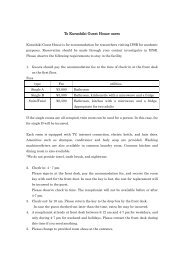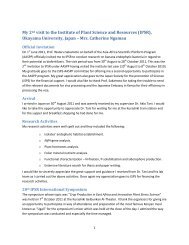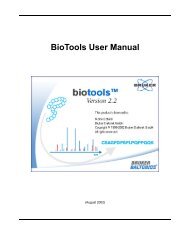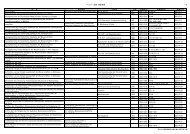Institute of Plant Science and Resources
Institute of Plant Science and Resources
Institute of Plant Science and Resources
Create successful ePaper yourself
Turn your PDF publications into a flip-book with our unique Google optimized e-Paper software.
Genetic <strong>Resources</strong> Unit<br />
Group <strong>of</strong> Genetic <strong>Resources</strong> <strong>and</strong> Functions<br />
Pr<strong>of</strong>essor Shin Taketa<br />
Assistant Pr<strong>of</strong>essor Naoki Shitsukawa<br />
This group was formed 1) to isolate useful genes from genetic resources including<br />
barley <strong>and</strong> its allied species, <strong>and</strong> 2) to analyze the roles <strong>of</strong> these genes by various<br />
approaches. Barley is the world’s fourth most important cereal crops, <strong>and</strong> the Center<br />
maintains a large barley collection from all over the world. Our main interest is genes<br />
controlling seed / flower morphology <strong>and</strong> quality-related characteristics.<br />
1) Genetics <strong>of</strong> the covered/naked caryopsis character in barley<br />
Typical barley cultivars have caryopsis with adhering hulls at maturity, known as<br />
covered (hulled) barley. However, a few barley cultivars are <strong>of</strong> a freethreshing variant,<br />
called naked (hulless) barley. Covered barley is used as an animal feed <strong>and</strong> for<br />
brewing, although naked barley is well suited for use as human food. The<br />
covered/naked caryopsis is controlled by a single gene (nud) on chromosome arm 7HL.<br />
Using positional cloning, we found that an ethylene response factor (ERF)<br />
transcription family controls the trait. Functional analyses <strong>of</strong> Nud/nud gene are<br />
underway (Lower left panel).<br />
2) Analyses <strong>of</strong> floral homeotic genes in barley<br />
Despite the importance <strong>of</strong> barley as a crop <strong>and</strong> many unique mutant collections, only a<br />
few genes that function in inflorescence development have been identified. The floral<br />
organ formation <strong>of</strong> higher plants has been explained using the “ABCDE model”.<br />
Basically, the ABCDE model can be applied also to monocot plants, but some<br />
unsolved problems exist for grass species. For example, the molecular entity <strong>of</strong> class<br />
A gene, which regulates specification <strong>of</strong> outer floral organs, <strong>and</strong> the mechanism <strong>of</strong><br />
whorl-specific regulation are still under debate. To answer these questions, we are<br />
studying expression pr<strong>of</strong>iles <strong>of</strong> barley homeotic genes, <strong>and</strong> are attempting to identify<br />
new inflorescence genes by screening rich barley mutant collections (Lower right<br />
panel).<br />
<br />
Barley caryopsis <strong>of</strong> covered (left)<br />
<strong>and</strong> naked (right) cultivars.<br />
Floral organs <strong>of</strong> the WT barley (A). The fan mutant has<br />
additional stamens instead <strong>of</strong> lodicules (B). The KM2 mutant has<br />
split palea <strong>and</strong> lacks lodicules (C).


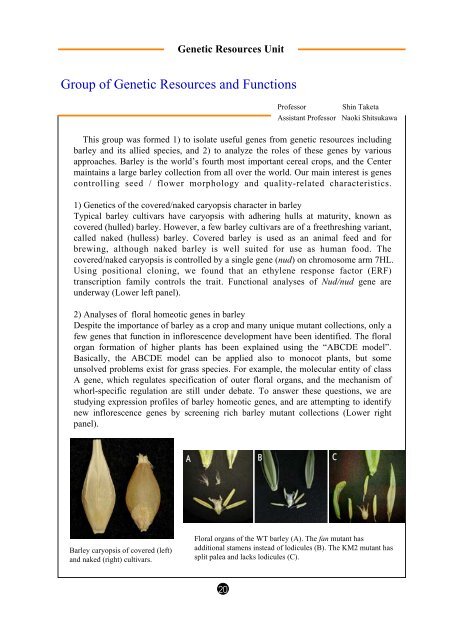

![[Application Forms to Tenure-track Assistant Professor] Applicants ...](https://img.yumpu.com/36047313/1/184x260/application-forms-to-tenure-track-assistant-professor-applicants-.jpg?quality=85)
